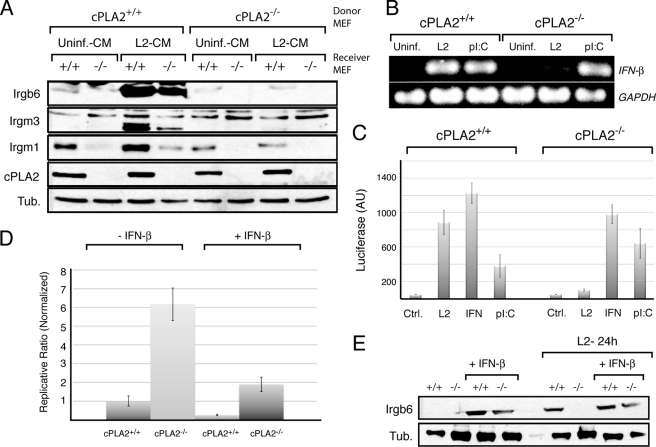FIGURE 6.
cPLA2−/− MEFs do not express type I interferons in response to C. trachomatis. A, conditioned medium from infected and uninfected cPLA2+/+ and cPLA2−/− MEFs were placed onto uninfected cPLA2+/+ and cPLA2−/− cells. The ability of the medium to induce IRG expression in uninfected cells was assessed by immunoblots with specific antibodies. Note that conditioned medium from L2-infected cPLA2+/+, but not cPLA2−/− MEFs, activates IRG expression in both wild-type and knockout MEFs. Also note the lower basal levels of IRG expression in cPLA2-deficient cells. B, expression of IFN-β in response to C. trachomatis infection (L2) was assessed by RT-PCR. cPLA2-deficient cells were incapable of expression IFN-β during C. trachomatis infection, but retained the ability to respond to poly(I:C). C, cPLA2+/+ and cPLA2+/+ MEFs were transduced with an IFN-inducible luciferase reporter construct and tested for luciferase activity in response to infection, IFN-γ and transfection of poly(I:C). C. trachomatis-dependent induction of the luciferase reporter is dependent on cPLA2. D, cPLA2+/+ and cPLA2−/− MEFs were treated with 100 units/ml of IFN-β and assessed for expression of IRG proteins by immunoblot. Both wild-type and cPLA2 deficient MEFs are capable of responding to treatment with IFN-β. Irgm1 and Irgm3 were similarly induced (not shown). E, cPLA2+/+ and cPLA2−/− MEFs were infected C. trachomatis (L2), treated with 100 units/ml of IFN-β and bacterial replication was assessed by the generation of infectious units. Both wild-type and cPLA2-deficient cells are capable of containing bacterial growth after treatment with IFN-β. Results shown are representative of at least three independent experiments.

